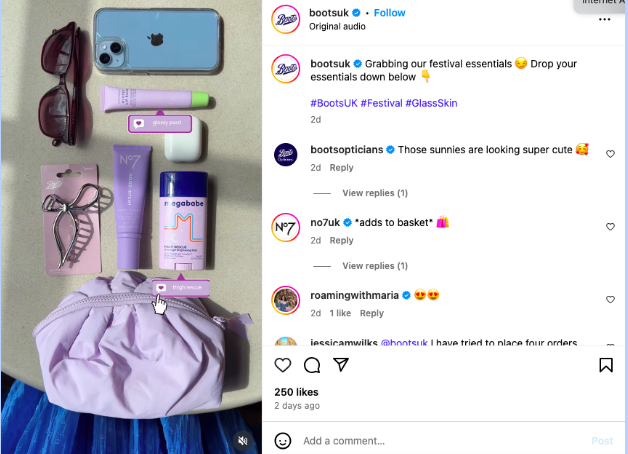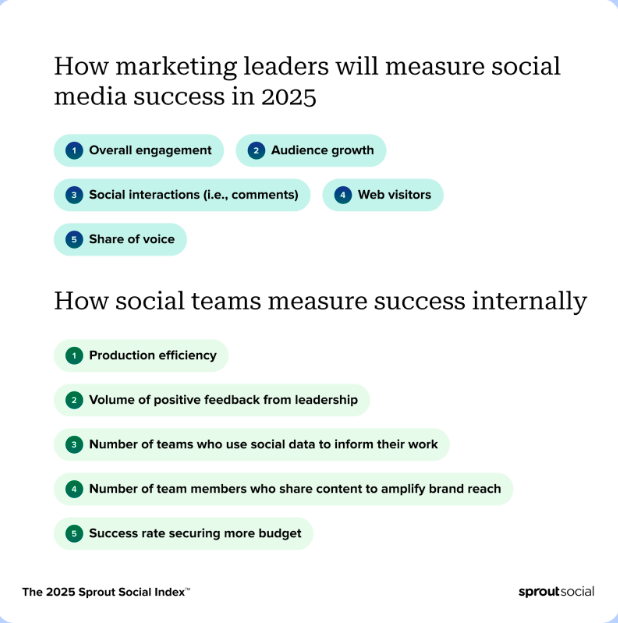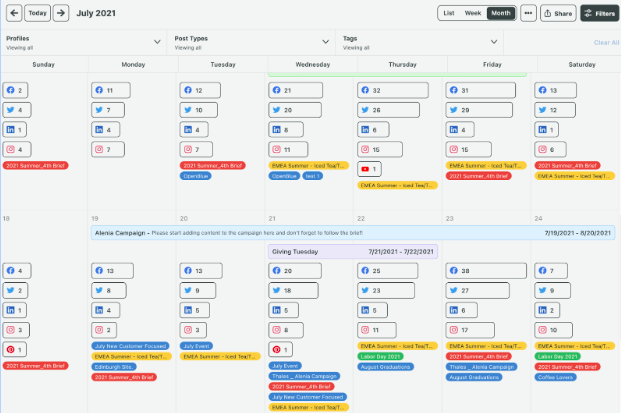What are social media content pillars? (plus examples to get you started)

Table of Contents
A strong social media marketing strategy relies on more than just consistent posting. It requires diverse content that captures your audience’s attention, and keeps it. One of the best ways to simplify your planning and stay strategic is by building social media content pillars: the core themes that keep your content focused, purposeful and aligned to your goals.
Originality plays a major role in this. According to The Sprout Social Index™ 2025, today’s consumers say that content originality is one of the top ways a brand can stand out—second only to the quality of their service.
In this article, we explain what social media content pillars are, and how brands are using them to guide their strategy. Plus, you’ll walk away with a step-by-step process to create your own pillars to refine your social content output.
What are content pillars in social media?
Social media content pillars are the key themes or content types you consistently create and share across your social media profiles. Each pillar typically aligns to a specific purpose, audience or content format.
They’re called “pillars” because they act as structural support for your strategy, like the columns of a Greek temple. They’re used to keep your content consistent and relevant across each of your accounts.
Every brand should establish a set of content pillars. Ideally, these will overlap across all of your platforms, though some may be more important for certain networks based on its audience and features. For example, a trendspotting pillar might be used more often on TikTok than on LinkedIn. As a general rule, you should have at least around 3-5 pillars at any one time. You should avoid having too many pillars, as this can dilute your brand’s message.
If you’re a food and beverage brand, for example, your main social media content pillars might be:
- Brand messaging reels
- User-generated content (UGC)
- Influencer or celebrity collaborations
- Product-focused recipe content
- Entertaining meme content
These are just a few examples; we explore more real-world examples below to help you find the right fit for your brand.
Why are content pillars important for social media?
Social media content pillars streamline your content planning process. They give you a clear direction on the type of content you need to be making, and why.
Pillars also help ensure each post serves a purpose, speaks to a specific audience and reinforces your brand identity. When your content ladders up to defined pillars, your messaging stays aligned across all your social platforms.
They also help you diversify your content, so you’re posting different types regularly.
Common examples of social media content pillars
Below, we’ve collected some examples of social media content pillars from brands across industries, and explained how each can achieve certain goals. Keep in mind: content pillars aren’t one-size-fits-all. Use these examples as inspiration, but tailor your pillars to reflect your brand values and the uniqueness of your audience.
Brand messaging and storytelling content pillars
Brand messaging content is a pillar that focuses on topics that revolve around your brand’s core identity. This might be an Instagram Reel that shows off your company’s history or narrative, carousels that detail your mission statement or promo videos that visualize your positioning.
Use this pillar to build awareness, as well as trust in your brand and its values. This can be useful for recruitment, and for building customer relationships.
Of all these examples, this pillar is perhaps the one with the most flexibility, as its success depends on how well you align the content to the brand itself. Here’s a recent example from the UK chocolate brand Hotel Chocolat.
They filmed a Reel with their company founder on location at the company’s first cacao farm. The video narrates the history of their products, as well as the company itself. It succeeds because this content couldn’t be effectively reproduced by any other brand; it relies on the distinct heritage of Hotel Chocolat.
Entertaining content pillars
This content pillar involves any content created to connect with your audience and brighten their day. It might take the form of comedic sketches, vibrant podcast conversations or professional adverts made with entertainment in mind.
Entertaining content also helps build brand awareness and can increase the reach of your content, particularly if you combine it with trends.
Creating entertaining social media content is its own challenge, and is an area of social media that’s constantly evolving. It’s worth researching how your competitors entertain their audiences, and thinking about how you can authentically adapt trends.
An interesting example of this type of pillar is the UK supermarket chain Waitrose and its Dish Podcast.
The Dish podcast is entertaining thanks to its celebrity hosts, TV chef Angela Hartnett and Nick Grimshaw, who is a UK radio celebrity. It’s also built a large following because it’s combined two favourite pastimes of social media: entertainment and food. They use celebrities and influencers and food-focused interviews to engage viewers while still staying relevant to what the brand offers.
Promotional or product-focused content pillars
This pillar covers content specifically created to promote your products. It might include feature breakdown carousels for software tools, demonstrations of how your service works or a reel of the general public trying your product for the first time. It’s also common for this pillar to merge with limited-time sales or promotional dates like Black Friday.
The goal of promo content is usually to convert followers into sales. For example, UK pharmacy chain Boots promotes several products for festival-goers. The update has a clear audience and has been timed to go live during the peak of the UK festival season in the summer. Posts like this often rely on a social media content calendar to organize well-timed promotional content. You can push your social audience towards time-sensitive exclusives or deals that can increase conversions.
User-generated content pillars
User-generated content (UGC) is a powerful content pillar—especially for lean marketing teams. These campaigns allow your audience to create and share content on your brand’s behalf. This might be in the form of product testing, competitions or charity challenges.
UGC builds reach and engagement. It can maximise your reach by leveraging brand ambassadors to increase your visibility in niche areas. It can also build and foster customer loyalty, keeping your brand in the forefront.
UGC not only lightens your content creation load, it also builds deeper engagement. Featuring your audience’s content can foster trust, strengthen community and spark organic conversations around your brand.
One way to maximise the impact of your UGC content pillar is to turn it into timed, recurring content drops. UK clothing brand Lucy & Yak do this with their content pillar #YakMirrorSelfieMonday.
They incentivise content creation by offering winners a £25 “YakToken” which can be used to purchase their products. These selfies advertise Lucy & Yak products, while encouraging community engagement.
How to create social media content pillars for your brand
Now that you’ve seen some successful social media content pillar examples, here’s actionable advice on how to build your own.
Step 1: Define your brand’s goals and audience personas
Think of content pillars as ladders, each one helping you move closer to your broader business objectives. To effectively create pillars, first look at your overall brand goals. Review the goals made by your leadership team, and think about how each of them could be achieved through your content pillars.
Look at how your brand goals connect with your audience personas, as this will help determine the purpose of each pillar. Think about what your audience wants to see from your content, and how you can match this with your core objectives.
Some popular objectives include raising brand awareness, generating leads or strengthening your community. The clearer your social media goals and audience personas are, the easier it’ll be to develop successful, long-lasting content pillars.
Step 2: Audit your existing content for themes and performance
Even if you haven’t been using social media content pillars before now, you’ve likely still been posting regularly. Audit everything you’ve posted until now, and track what’s worked well.
Look for patterns among your top-performing posts; these can help you define your future content pillars.
Align your social metrics to your business goals, and track each of them regularly to help identify the best indicators of what’s working. If you’re looking to build a community for example, track comments and shares. If you want to raise brand awareness, look at reach and likes. This will determine which of your pillars is performing well, and which need to be optimized. Think also about how overall success on socials is measured by marketing leaders today, according to the 2025 Sprout Social Index, like overall engagement, audience growth and social interactions.
Once you’ve identified relevant patterns in your data, you can start to formally strategise your pillars.
Step 3: Choose 3-5 repeatable content pillar themes
Define around three to five core themes that can serve as your main content pillars. Prioritise any that occurred naturally while auditing your existing content first. Also, look at what’s missing from these pillars, and create one or two more pillars to fill these gaps.
Try to strike a balance between your brand’s priorities and what your audience is interested in. To do this, map out the main goals of each pillar and determine how aligned they are with both your audience personas and your core social media objectives.
Remember that unlike Greek temples, your social media content pillars don’t have to be set in stone. You can review them again in a few months’ time, and can also add new pillars if you notice an emerging opportunity.
Step 4: Plan your mix across channels
Once you’ve defined your pillars, plan how to bring them to life across your different social channels.
Each of your pillars should change slightly based on the platform you’re using. For example, you might flex your product-focused pillar as an Instagram Reel, but then turn this into a demo breakdown video for TikTok or an interactive webinar for LinkedIn.
If you’re unsure how to tweak your social media content pillars across different platforms, refer to Sprout’s 2024 Social Media Content Strategy Report. In it, you’ll find data-driven insights into which content formats and types should be prioritised on each network.
How to measure the performance of your social media content pillars
Once your content pillars are in place and you’re consistently creating content around them, it’s time to track how each one is performing. Performance measuring is much easier if you use Sprout Tagging.
Create a separate, unique Tag for each of your pillars, and tag every piece of content you upload with its respective pillar. You can view tagged content across your calendar to make sure you’re diversifying your output.
Then, use the Tag Performance Report to track how individual content is performing across each of your pillars. Formalise this process into a tagging strategy to gain clearer insights into which pillars work best for your brand, and which need tweaking or changing.
Build your social media content pillars to boost content performance
With defined social media content pillars, you can create a more effective social content calendar and work to better achieve your wider social media goals. The more insight you have into content performance, the easier it is to refine your pillars over time.
Combine your pillars with more insights into social media content expectations by downloading the 2025 Sprout Social Index™. You’ll find an overview of user expectations, as well as data that can inform how you build your social team to prepare for the future of digital marketing.
Social Media Content Pillar FAQs
What are some common mistakes teams make with social media content pillars?
One common mistake is not thinking about which pillars will work best on which social platforms. Make sure pillars overlap, but think about which networks and audiences work best with them. Another mistake is not refining or changing your pillars over time as your business grows and your audience evolves.
What are the three E’s of social media content pillars?
The 3 E’s stand for engage, entertain and educate. These should be the foundational pillars of your strategy. Everything you post on socials should be doing at least one of these three.








Share